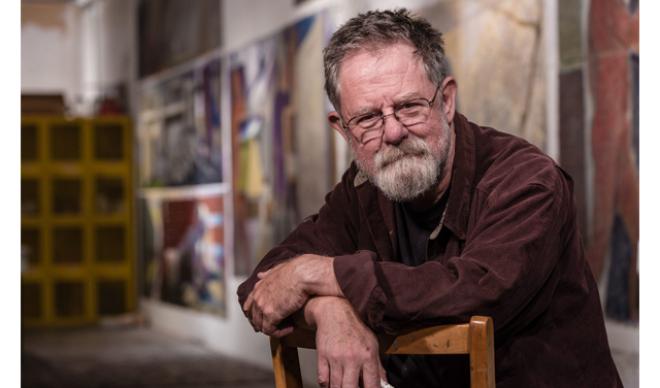
This story is included in the most recent issue of Quest Magazine, the College's twice-yearly Alumni publication. To view the entire issue online, or to view longer-form "Quest Extra" pieces, click here.
Dr. Garth Claassen likes to let his artwork and his behavior speak for him, and they speak volumes.
They tell the story of:
- An adventurous man who moved more than 10,000 miles from South Africa to put down roots in Caldwell, Idaho, yet never abandoned the lessons about humanity he learned from apartheid.
- An inventive and adaptable studio artist who switched from sculpting to painting at mid-career and achieved marked success after doing so.
- A quiet and unassuming professor of art who taught art history and studio art at The College of Idaho for 29 years while also making gentle suggestions that changed people’s lives.
- An optimistic new retiree who is building a studio at his home, looking forward to new inspiration in that context, and seeking opportunities to exhibit new works.
Claassen started teaching at the College in 1994, armed with a doctorate in art history from Indiana University in Bloomington. He continued sculpting, focusing on ceramics as he had since the 1970s, until his first sabbatical, when he began to experiment with oil stick. The experiment never ended; he left sculpting behind.
His talent has earned him three fellowships – the most allowed for any one artist – from the Idaho Commission for the Arts. Claassen is only the fourth person in the fellowship’s history to be recognized three times.
He has mounted two solo exhibitions at the Boise Art Museum and exhibited works at many other galleries, including the South African National Gallery and the Idaho State Historical Museum.
Clearly influenced by apartheid, Claassen creates pictures of enforced separation and barriers – pictures that invite the viewer into conversation. “I wouldn’t describe myself as an activist,” he says. “I’m a bit introverted. I find if I make art that brings up those kinds of issues, then that’s an opportunity to talk about them.”
He also serves as director of the Rosenthal Gallery of Art on campus and has joined Dr. Steve Maughan ‘85, professor of history, and Dr. Sue Schaper, professor of English, in co-leading student trips to London for the past 20 years.
Nikki Abercrombie ’11, Beaverton, Oregon, calls her London trip life-changing. “Garth gave me my favorite college-learned skill that I use on a daily basis: a hobby!” she says. Sketching was required on the trip; she followed up with a painting course her final semester. “I was nervous and didn’t think I was very good, but Garth saw my potential and encouraged me,” she says. “One of my few regrets from C of I is that I didn’t start taking art courses sooner. … I have an easel always set up in my house, and I paint … as a form of stress relief.”
Abercrombie is but one example of Claassen’s engagement with students. “I try to meet the students where they are,” he says, noting that students have varied backgrounds and lead complicated lives – and that teaching studio art allows for much one-on-one time. “I find students interesting, so it’s easy to be engaged.”
As he opens the newest chapter of his life, he is focused on his art and will teach only a single class in the fall. Once his wife, Dr. Karen Brown, retires next year from her position as associate professor of art at College of Western Idaho, they intend to travel to France to “see some of the things I’ve been teaching about.”
The College of Idaho has a 132-year-old legacy of excellence. The College is known for its outstanding academic programs, winning athletics tradition, and history of producing successful graduates, including eight Rhodes Scholars, three governors, and countless business leaders and innovators. Its distinctive PEAK Curriculum challenges students to attain competency in the four knowledge peaks of humanities, natural sciences, social sciences, and a professional field—empowering them to earn a major and three minors in four years. The College’s close-knit, residential campus is located in Caldwell, where its proximity both to Boise and to the world-class outdoor activities of southwest Idaho’s mountains and rivers offers unique opportunities for learning beyond the classroom. For more information, visit www.collegeofidaho.edu.